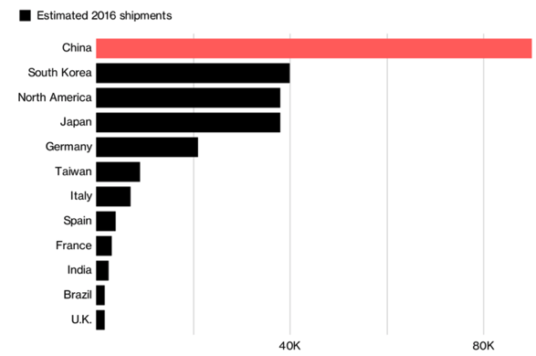
Podcast & Transcript: A View from France
Cobots: Progress, Potential and Overcoming Challenges for Adoption
Natalie Pierce, the Co-Chair of Littler's Robotics, AI, and Automation Practice Group and Guillaume Desmoulin of Littler's Paris office (Fromont Briens) discuss collaborative robots – or cobots in the EU and France
Full podcast plus transcript excerpts from Natalie and Guillaume’s podcast on cobots’ increasing integration
into the workforce and identify growth opportunities in several industries.
Opener: Welcome to the Littler Artificial Intelligence and Robotics podcast. Conversations about employers integrating robotics and A.I. systems into their workplaces in the United States and worldwide.
Natalie: This is Natalie Pierce. As listeners to some of my previous programs and podcasts well know, I’m a cobot fan. I am also the co-chair of Littler’s Robotics, Artificial Intelligence and Automation Practice Group. I think that we’re going to continue to see increased adoption of cobots because of how easily integratable collaborative robots are into workplaces. So today this is where we’re going to focus. And I’m so happy to be joined by Guillaume Desmoulin of Littler’s Paris office. Welcome Guillaume.
Guillaume: Thank you. Natalie hello everybody.
Natalie: You are also a fan of collaborative robots. What makes them a special form of robotics?
Guillaume: Well, because it is mainly implemented in cages where robotic only, so classical industrial robotic does not have any justification. And where human intervention is necessary, in other words, cobots are more conceived as an assistance and a substitute to humans in this way. Just like you, I’m a great fan of cobots.
Natalie: We’re seeing collaborative robots evolve in so many ways the adaptive grippers to performing easily identified and programmable programs from lab tests to small packaging. Those have been real game changers. Just for those who perhaps have not listened to previous podcasts. What kinds of cobots have you seen in action in Europe and elsewhere?
Guillaume: Well let’s say that there are three main kinds of cobots we can currently see in France and other countries in Europe. The first I would say the main kinds of cobots that we can currently see is what we call collaborative robots driven by an operator located very close to the system. The second big type would be robots driven remotely from another room or even from home. And the last kind I would say is starting slowly in Europe; it’s what we call exoskeleton which is obviously the most impressive.

Natalie: You and I shared some information about the last study from the International Federation of Robotics, which was published a couple of years ago, 2017. And at that point there were 1,828,000 active industrial robots. By next year, it’s anticipated that this is going to increase to 3,053,000. And South Korea is one of the countries with the highest number of robots per person. But China is definitely showing the highest growth. What is happening in Europe and particularly, since you’re sitting in Paris, what’s happening in France?
Guillaume: This is definitely increasing just like everywhere else in the world. Just to give you some idea of everybody, not only in France, but also in Europe and even in the world, we know that as of today there is something like 23,000 cobots in place in the world. However, we know that in 2020 almost half of industrial robots that would be sold in the world would be collaborative robots, so we can definitely see a great increase of cobots among the global world of industrial robots.
Generally speaking, regarding Europe, we know that there’s a great increase with a specific hot spot which is Germany, where it’s really well used for many years, because there are great industrial companies there.
And also, specifically, that France remains very late. Generally speaking, on industrial robotics, because we have something like 2500 robots whereas Germany has 21000 however. And she’s probably a sign of hope. What do we call good about robotics as a really special place in France. Classical industrial robotics it’s much harder because we don’t have the same size of industry that exist in Germany; but in France, especially with all our specific healthcare industry and aerospace industry.
We really do have a need for collaborative robots and which is great because we have also great opportunity and that’s something very important that I want to point out. France really offers a wide range of solutions with many significant companies already working in the market.

Natalie: Well, we wouldn’t be lawyers if we didn’t also focus on the challenges and potential risks. And I think that does have something to do with the rate of adoption. So, what have you been seeing in Europe as some of the challenges to adoption as the technology continues to advance?
Guillaume: Well, I would mention mainly three downsides.
The fact is, because of the limitation of moves that can be created by the use of cobots, sometimes it can also lead to somebody who’s got musculoskeletal disorder. I believe it’s pretty rare, but we know that there exists outside health issues that should be taken care of as well as of course collision with a robot because of a bad use of common sense.
We also know that one of the downsides is the loss of autonomy which can be felt by the worker. It sets as a reason of course with the employee it sets a method as a process so that the worker can have the feeling that he is losing initiative and creativity.
This is why it’s recommended to involve the employee at a very early stage of the implementation of the cobots, so that it can still feel being a part of the system and being in charge of the system. It is just, you know, a cool worker with a cobot. Then we can have this risk and we know that there’s also a stress arising from working in close relationship with the cobot. There’s an interesting case about the presence and the movement. So, it’s an additional stress that didn’t exist before for workers. So, I would say these are the main downside but again this can be easy to solve with sufficient training.
Natalie: You are seeing some industry slow to adopt. What do you attribute some of that reluctance?
Guillaume: Well, first of all I think the majority of French employers are reluctant to invest into cobots because they fear that it may be a significant cost, which it is and everybody knows it as a false reason.
Most studies, as everybody knows, is reimbursed in less than a year. And cobots are also much less expensive than classical industrial robots, so there’s no financial reason to actually resist to this. However, from studies that have been made, we know that some French employers are reluctant probably because there is the fear of job destruction. Again, this is something I would say is more psychological rather than economical. And it’s probably the strongest reason for reluctance.
And again, this is a false reason because we know again from statistics that this is just not true. In 2018, for instance, 71 percent of working hours were performed by human and 29 percent by machines.
We know that this would stay the number of working hours before any for, humans will decrease. That’s for sure. But at the same time, some new jobs would be created, and I would say, higher skilled and we know this from example from other countries who will be implemented this specific robotic.
We know that countries with a high rate of robots are not the ones with a high rate of unemployment. So, there is no direct link between the implementation of cobots and high unemployment. So, this is again, I would say, a wrong fear. Actually, on these least qualified jobs, some will have skills, and that’s good. This is where an important work of training and education is needed, not only for adapting workers to cobots but also for putting down this fear of cobots. I would say that generally speaking it is reluctance resulting in a lack of knowledge about what really is good about cobotics.

Automation of Jobs & Managing Employee Morale
How employers can preserve employee morale
by proactively explaining the benefits of automation

